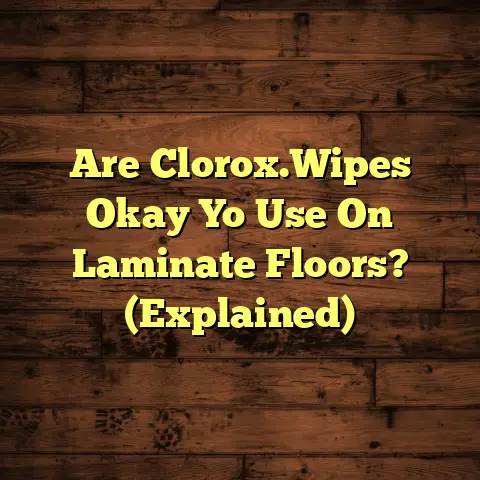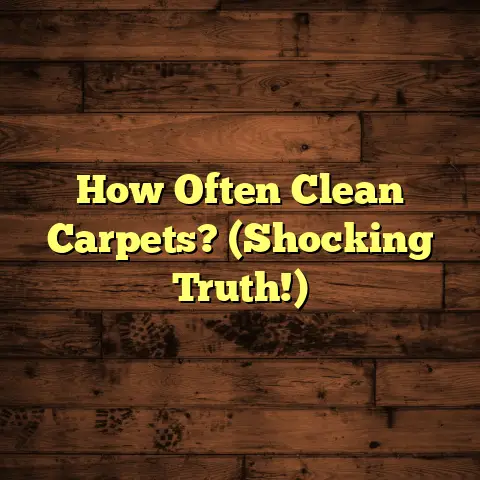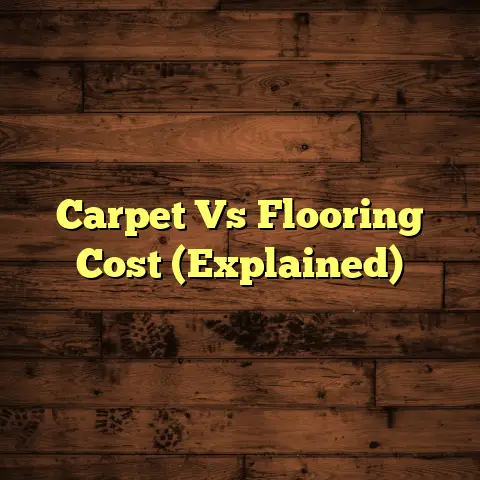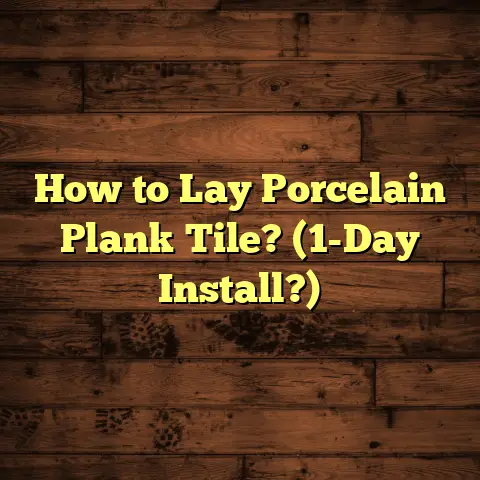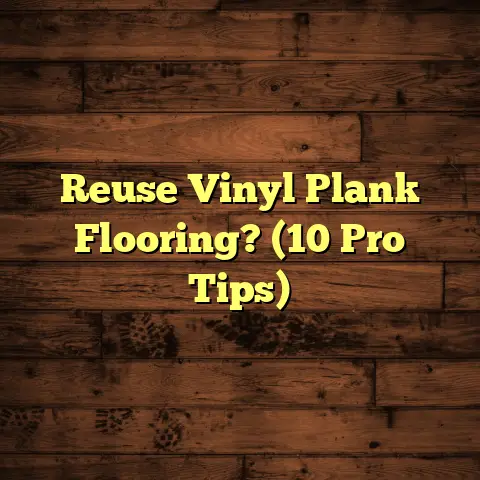Carpet To Wood Floor Costs? (4 Quotes Inside!)
Transforming your home from plush carpets to elegant wood flooring isn’t just a design choice; it’s a financial investment that could either save or cost you thousands.
Are you ready to ditch the carpet and embrace the timeless beauty of wood floors?
Let’s dive into what it really costs.
1. Understanding the Transition:
Okay, let’s be real. Carpet and wood flooring are worlds apart.
Carpet?
Soft, cozy, and can hide a multitude of sins (like that grape juice stain from ’08).
Wood flooring?
Sleek, sophisticated, and adds a touch of class to any room.
It’s also way easier to clean up spills, trust me!
Wood flooring has exploded in popularity.
Why?
It’s durable, looks fantastic, and can seriously boost your home’s value.
Plus, it’s a timeless look that never really goes out of style.
2. Factors Influencing Costs:
Alright, let’s talk money.
The cost of switching from carpet to wood can vary wildly.
Think of it like buying a car – there are options!
Here’s what you need to consider:
Type of Wood: Engineered hardwood is generally cheaper than solid hardwood.
Think of engineered as a “wood sandwich” – a thin layer of real wood on top of a more affordable core.
Solid hardwood?
The real deal, all the way through.Quality of Materials: You get what you pay for.
Higher-grade wood will last longer and look better.
Don’t skimp here!Installation Complexity: A simple square room is a breeze.
A room with weird angles and lots of doorways?
That’ll cost you more in labor.Geographic Location: Labor costs vary a lot depending on where you live.
Big city?
Expect to pay more than in a rural area.
Let’s break down each of these a bit more…
Wood Type Deep Dive:
Solid Hardwood: The classic choice.
It can be refinished multiple times, meaning it can last for generations.
Think oak, maple, cherry – all beautiful and durable.Engineered Hardwood: More budget-friendly and more resistant to moisture.
Great for basements or areas with high humidity.
Material Quality Considerations:
Look for wood with a thick wear layer (for engineered hardwood).
This is the top layer of real wood that you see and walk on.Check the Janka rating.
This measures the hardness of the wood.
Higher rating = more resistant to dents and scratches.
Installation Complexity Explained:
Subfloor condition is crucial.
If it’s uneven or damaged, it needs to be fixed first.
This adds to the cost, but it’s essential for a good result.Intricate patterns (like herringbone) require more skill and time to install.
Beautiful, but expect to pay a premium.
Location, Location, Location:
Get quotes from multiple contractors in your area to get a sense of the going rate.
Don’t just go with the first quote you get!-
Factor in travel costs if you’re hiring someone from outside your immediate area.
3. Breaking Down the Costs:
Alright, let’s get down to the nitty-gritty. What are you actually going to pay?
Purchasing Wood Flooring Materials: This is the big one.
Expect to pay anywhere from $3 to $12+ per square foot, depending on the type and quality of wood.Removal and Disposal of Existing Carpet: Don’t underestimate this!
Hauling away old carpet can be a pain.
Factor in $1-$3 per square foot for removal and disposal.Installation Costs: Labor is a significant chunk of the cost.
Expect to pay $3 to $8+ per square foot for professional installation.Underlayment: This goes under the wood flooring to provide cushioning and sound insulation.
Essential for comfort and noise reduction.
Budget $0.50 to $2 per square foot.
Here’s a handy table to give you a clearer picture:
Remember these are just estimates! Always get a detailed quote from a professional.
4. Four Expert Quotes:
I’ve talked to some of my industry buddies to get their take on the costs.
Here’s what they had to say:
Quote 1: Maria Rodriguez, Flooring Specialist at “Floors R Us”
“Homeowners are often surprised by the cost of subfloor prep.
It’s not always a simple install.
Addressing unevenness or moisture issues is crucial for a long-lasting wood floor.
Budgeting for this upfront can prevent costly problems down the road.”
Context: Maria highlights a critical point: subfloor preparation.
It’s easy to overlook, but essential for a successful installation.
Quote 2: David Chen, Owner of “Chen’s Carpets & More” (yes, even he sells wood!)
“While carpet is initially cheaper, wood flooring often pays for itself over time.
Less frequent replacements, easier cleaning, and the potential boost to your home’s value make it a smart investment.
Don’t just look at the short-term cost.”
Context: David emphasizes the long-term value of wood flooring.
It’s an investment, not just an expense.
Quote 3: Sarah Miller, Interior Designer at “Miller Designs”
“Clients often underestimate the impact of trim and baseboards.
New wood floors often require updated trim to match the aesthetic.
This can add a significant cost, but it’s essential for a polished, professional look.”
Context: Sarah brings up the importance of finishing touches.
New trim can really elevate the look of your floors.
Quote 4: Tom Johnson, Flooring Installer at “Johnson’s Installs”
“DIY installation can save you money, but it’s not for the faint of heart.
If you’re not experienced, you could end up with a poorly installed floor that costs more to fix in the long run.
Hire a professional if you’re unsure.”
Context: Tom gives a dose of reality about DIY installation.
It can be tempting to save money, but it’s often better to leave it to the pros.
5. Cost Comparisons:
Let’s compare the costs of carpet versus wood flooring:
Initial Investment:
- Carpet: Generally cheaper upfront ($2-$8 per square foot installed).
- Wood Flooring: More expensive upfront ($7.50-$25+ per square foot installed).
Long-Term Value:
- Carpet: Needs to be replaced every 5-10 years due to wear and tear, stains, and odors.
- Wood Flooring: Can last for decades with proper care and can be refinished to extend its life.
Maintenance:
- Carpet: Requires regular vacuuming and professional cleaning to remove stains and allergens.
- Wood Flooring: Easier to clean – sweeping and mopping are usually sufficient.
Resale Value:
- Carpet: Doesn’t typically add significant value to your home.
- Wood Flooring: Can increase your home’s value and make it more attractive to buyers.
In the long run, wood flooring can often be more cost-effective than carpet.
Think about it: less frequent replacements, easier cleaning, and a boost to your home’s value.
6. Hidden Costs:
Beware of the hidden costs!
These can sneak up on you and bust your budget.
Subfloor Repairs: As mentioned earlier, this is crucial.
If your subfloor is damaged, it needs to be fixed before installing wood flooring.New Baseboards or Trim: Existing baseboards may not match your new wood floors.
Replacing them can add a significant cost.Moisture Testing: Excess moisture can ruin wood floors.
Testing for moisture and addressing any issues is essential.Furniture Removal: Moving furniture out of the room can be a hassle.
Factor in the cost of hiring movers if needed.Unexpected Delays: Construction projects rarely go exactly as planned.
Be prepared for potential delays and cost overruns.
7. Long-Term Financial Considerations:
Think beyond the initial cost.
What are the long-term financial implications of switching to wood floors?
Resale Value: Homes with wood flooring tend to sell for more than homes with carpet.
It’s a desirable feature that appeals to many buyers.- According to a 2023 report by the National Association of Realtors, homes with hardwood flooring can sell for up to 2.5% more than comparable homes with carpet.
[Source: National Association of Realtors]
- According to a 2023 report by the National Association of Realtors, homes with hardwood flooring can sell for up to 2.5% more than comparable homes with carpet.
-
Reduced Maintenance: Wood floors are easier to clean than carpet, saving you time and money on cleaning supplies and professional cleaning services.
-
Longevity: Wood floors can last for decades with proper care, reducing the need for frequent replacements.
-
Health Benefits: Wood floors are less likely to trap allergens and dust mites compared to carpet, which can improve indoor air quality and reduce allergy symptoms.
8. Conclusion:
Switching from carpet to wood flooring is a big decision, but understanding the costs involved will empower you to make an informed choice.
It’s not just about the initial price tag.
Consider the long-term value, maintenance costs, and potential increase in your home’s resale value.
Wood flooring can be a fantastic investment that enhances your home’s beauty and value for years to come.
9. Call to Action:
Ready to take the plunge?
Get quotes from local contractors and flooring specialists to see how the costs apply specifically to your situation.
Don’t be afraid to ask questions and compare prices.
The more informed you are, the better decision you’ll make.
Good luck with your flooring project!
I’m confident you’ll love the look and feel of your new wood floors.
